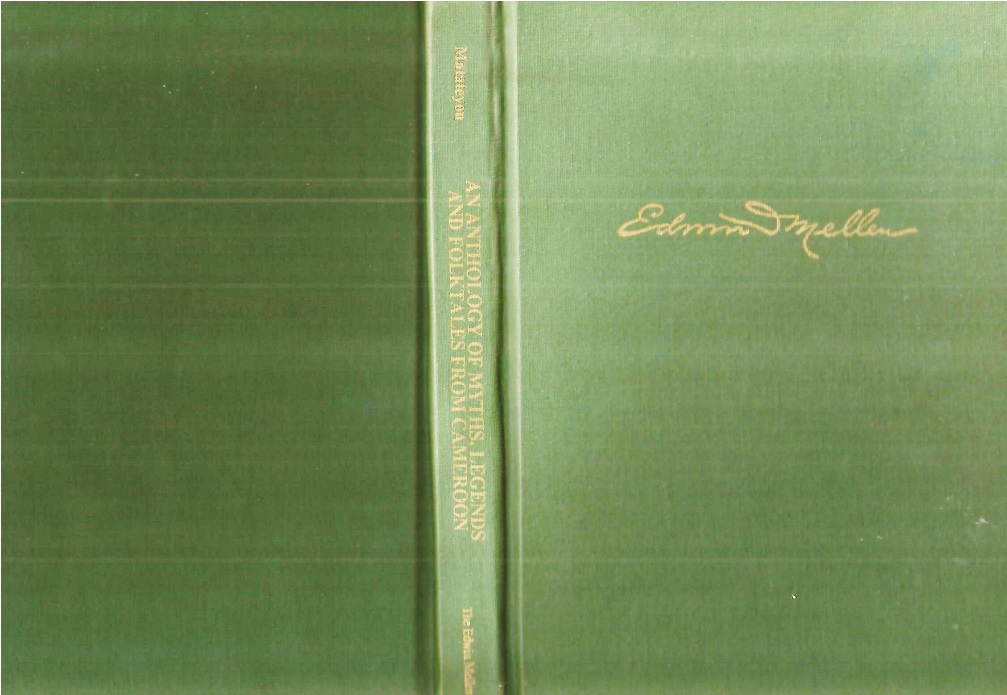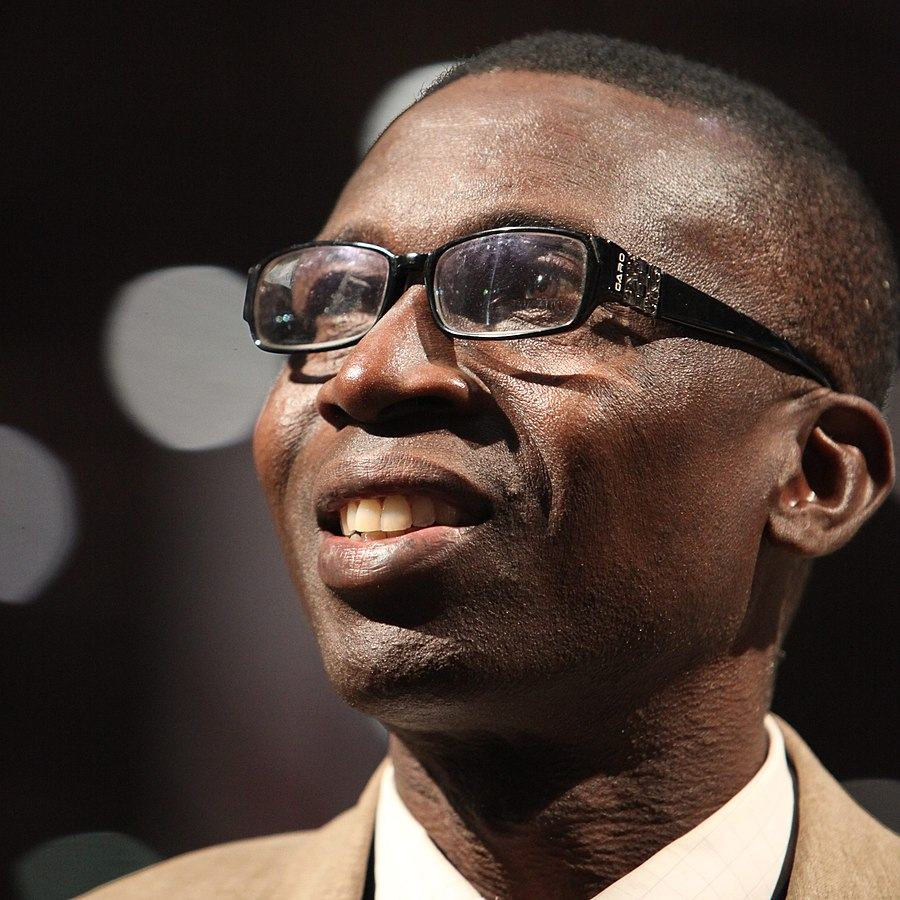Title of the work
Country of the First Edition
Country/countries of popularity
Original Language
First Edition Details
Emmanuel Matateyou, An Anthology of Myths, Legends and Folktales from Cameroon. Lewiston: Edwin Mellen Press, 1997, 255 pp.
Country of the Recording of the Story for the Database
Full Date of the Recording of the Story for the Databasey
More Details of the Recording of the Story for the Database
Genre
Myths
Target Audience
Crossover
Cover

The cover of An Anthology of Myths, Legends and Folktales from Cameroon by Emmanuel Matateyou. Courtesy of The Edwin Mellen Press Ltd.
Author of the Entry:
Daniel A. Nkemleke, University of Yaoundé 1, nkemlekedan@yahoo.com
Peer-reviewer of the Entry:
Divine Che Neba, University of Yaoundé 1, nebankiwang@yahoo.com
Elizabeth Hale, University of New England, ehale@une.edu.au

Emmanuel Matateyou by Rama. Retrieved from Wikimedia Commons, licensed under Cc-by-sa-2.0-fr (accessed: December 15, 2021).
Emmanuel Matateyou
, b. 1952
(Author, Storyteller)
Emanuel Matateyou is a writer and a professor at the Ecole Normale Supérieure, University of Yaoundé 1. He is a former Fulbright scholar and has published widely on oral literature and Cameroonian culture and languages. Some of his publications include: An Anthology of myths, legends and folktales from Cameroon (1997), Les Merveilleux récits de Tita Ki (2001), Parlons Bamoun (2001), Problématique d’une conciliation du réel et l’irréel (1999), Les sociétés secrètes dans la littérature camerounaise le cas des Bamoun. 2. vol. (1990).
Bio prepared by Daniel A. Nkemleke, University of Yaoundé 1, nkemlekedan@yahoo.com

Martin Njoya (Storyteller)
Age of Narrator: 50 (in 1978)
Occupation: Farmer
Language: Bamun
Bio prepared by Daniel A. Nkemleke, University of Yaoundé 1, nkemlekedan@yahoo.com
Origin/Cultural Background/Dating
Cultural Background*: Njindare, Foumban
The Bamoun Kingdom (otherwise known as the Foumban kingdom) is bounded in the North West by Donga Mantung and Bui Divisions, West by Mifi Division, South by Bafia and Bangante and East by Banyo in the Adamawa region. The Kingdom was founded in 1390 by Nchare, a prince from Rifum (the present day Bankim), in the Adamawa Region of Cameroon. The Foumban traditional society is well structured with “Mfon” (King) at the head, closely assisted by the “Momamfon” the queen. Other custodians of culture include the notables. The Mfon is noted for his numerous wives and uncountable children. Other secret societies which assist in the administration of the Kingdom, both in the physical and spiritual realms, include the secret societies. Among them are the Nguri and Muitngu secret societies. Owing to the people attachments to the Gods, spirits and ancestors, the Foumban people pay particular attention the popular Nguon Festival (of fertility and protection), which has become a crowd pulling event in Cameroon for the past years. Gods and ancestors are worshiped during the festival and the spirit of sharing encouraged among the people by the king. The Foumban kingdom is one of the oldest kingdom in Africa and noted for the invention of their own form of writing, which was later pushed to the periphery.
* Sources:
Mamadou, Ntiecheles. Les conflicts Socio-politique dans le Royaume Bamoun de 1863- 1889, DIPESS II Dissertation, University of Yaoundé 1, 2000.
Fewoh, Paul Mouliom. Collectives Décentralisée et Developpement Local : le Cas de la Commune Ubaine de Foumban, DIPESS II Dissertation, University of Yaoundé , 2006.
Summary
The original published version of this myth appears in: An Anthology of Myths, Legends and Folktales from Cameroon by Emmanuel Matateyou, published in 1997 (pp. 31–33) by The Edwin Mellen Press Ltd. Although we have the written authorization of the publisher and the author to reprint up to 10 myths in the collection for our research on “Our Mythical Childhood…”., we have chosen to summarize this particular myth because the original version is too long. We are therefore very thankful to The Edwin Mellen Press Ltd and Professor Matateyou for granting us this permission.
In the beginning, God created the earth and also created man to inhabit it. He gave man the gift of everlasting life and everything he needed. For a long time, man was good and lived in peace and harmony with one another. After sometime however, people started committing all types of evil. This offended God and he decided to punish man with aging and death. This caused untold grief to humanity and God was forced to reconsider his position. Therefore, he offered humans two choices: resurrection after death and everlasting death. He asked humans to decide and then choose any animal to carry their decision to him. Humans debated for a long time and never agreed. They rather split into two camps: the good and kind people who stood for resurrection on one side, and the bad criminal people who argued strongly against. This latter group was afraid that the owners of the property they had confiscated by unlawful means, and killed them in the process, might come back to life and fight back. Finally, the bad people congregated secretly and commissioned the Chameleon to take their message to God. Fortunately, their scheme was whispered to the other camp that immediately dispatched the fleet-footed dog to outrun the chameleon and deliver their message. Before long, Dog outran Chameleon and was sure to win the race. Then Chameleon called his attention to some hare meat in the nearby bush. Assured of his running speed, the Dog sat down to eat. The meal was so delicious than he forgot himself. By the time he finished, Chameleon had already got to the Sky (Heaven) and delivered his message to God. Dog arrived and tried to protest but it was already late as God had already taken his decision.
Analysis
Death is a universal theme in human existence and myths associated to its origin abound in many world cultures. The myth has similar versions across the African continent in general and Cameroon in particular, with the main difference seen at the level of the different animal characters used. One of these characters often uses tricks to have an advantage over the other. The Zulu version of the myth uses the chameleon and the lizard as emissaries to God; the Bantu replace the lizard with the itoroko, a small bird in the thrush tribe, while the Ashante of Ghana use the sheep and the goat. All these myths revolve around the failure of delivery of a message. However, some myths on the origin of death blame it on punishment for disobedience, disagreements between gods and humans or gods and gods. Other myths blame the loss of eternity on some flaw in character like arrogance, forgetfulness, stubbornness, greed curiosity, and self-confidence as is the case with the myth.
This story also bears a resemblance to one of Aesop’s fables: The Hare and the Tortoise [Χελώνη και λαγωός], which uses the same motif of a race between a fast and a slow animal. The fable encourages children and young adults to have positive qualities and be cautious.
Further Reading
Beier, Ulli, The Origin of Life and Death, London: Heinemann, 1966.
Iloanusi, Obiakoizu, Myths of the Creation of Man and the Origin of Death in Africa: a Study in Igbo Traditional Culture and Other African Cultures, Indiana: Peter Lang Pub Inc., 1984.
Matateyou, Emmanuel, An Anthology of Myths, Legends and Folktales from Cameroon, New York: The Edwin Mellen Press Ltd, 1997.
Addenda
Collected by Emmanuel Matateyou.


